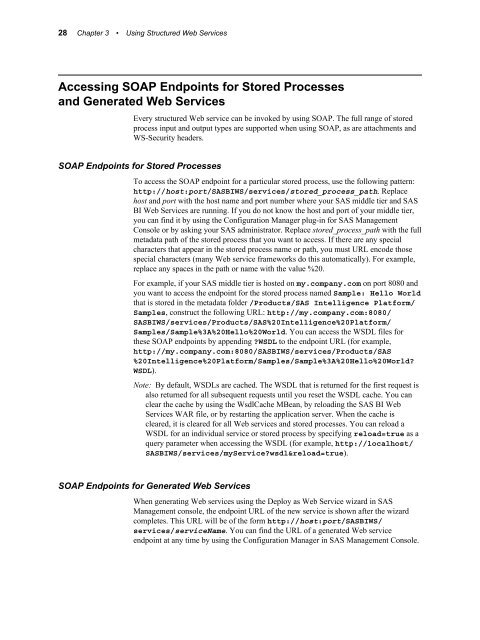SAS 9.3 BI Web Services Developer's Guide
SAS 9.3 BI Web Services Developer's Guide
SAS 9.3 BI Web Services Developer's Guide
Create successful ePaper yourself
Turn your PDF publications into a flip-book with our unique Google optimized e-Paper software.
28 Chapter 3 • Using Structured <strong>Web</strong> <strong>Services</strong><br />
Accessing SOAP Endpoints for Stored Processes<br />
and Generated <strong>Web</strong> <strong>Services</strong><br />
Every structured <strong>Web</strong> service can be invoked by using SOAP. The full range of stored<br />
process input and output types are supported when using SOAP, as are attachments and<br />
WS-Security headers.<br />
SOAP Endpoints for Stored Processes<br />
To access the SOAP endpoint for a particular stored process, use the following pattern:<br />
http://host:port/<strong>SAS</strong><strong>BI</strong>WS/services/stored_process_path. Replace<br />
host and port with the host name and port number where your <strong>SAS</strong> middle tier and <strong>SAS</strong><br />
<strong>BI</strong> <strong>Web</strong> <strong>Services</strong> are running. If you do not know the host and port of your middle tier,<br />
you can find it by using the Configuration Manager plug-in for <strong>SAS</strong> Management<br />
Console or by asking your <strong>SAS</strong> administrator. Replace stored_process_path with the full<br />
metadata path of the stored process that you want to access. If there are any special<br />
characters that appear in the stored process name or path, you must URL encode those<br />
special characters (many <strong>Web</strong> service frameworks do this automatically). For example,<br />
replace any spaces in the path or name with the value %20.<br />
For example, if your <strong>SAS</strong> middle tier is hosted on my.company.com on port 8080 and<br />
you want to access the endpoint for the stored process named Sample: Hello World<br />
that is stored in the metadata folder /Products/<strong>SAS</strong> Intelligence Platform/<br />
Samples, construct the following URL: http://my.company.com:8080/<br />
<strong>SAS</strong><strong>BI</strong>WS/services/Products/<strong>SAS</strong>%20Intelligence%20Platform/<br />
Samples/Sample%3A%20Hello%20World. You can access the WSDL files for<br />
these SOAP endpoints by appending ?WSDL to the endpoint URL (for example,<br />
http://my.company.com:8080/<strong>SAS</strong><strong>BI</strong>WS/services/Products/<strong>SAS</strong><br />
%20Intelligence%20Platform/Samples/Sample%3A%20Hello%20World?<br />
WSDL).<br />
Note: By default, WSDLs are cached. The WSDL that is returned for the first request is<br />
also returned for all subsequent requests until you reset the WSDL cache. You can<br />
clear the cache by using the WsdlCache MBean, by reloading the <strong>SAS</strong> <strong>BI</strong> <strong>Web</strong><br />
<strong>Services</strong> WAR file, or by restarting the application server. When the cache is<br />
cleared, it is cleared for all <strong>Web</strong> services and stored processes. You can reload a<br />
WSDL for an individual service or stored process by specifying reload=true as a<br />
query parameter when accessing the WSDL (for example, http://localhost/<br />
<strong>SAS</strong><strong>BI</strong>WS/services/myService?wsdl&reload=true).<br />
SOAP Endpoints for Generated <strong>Web</strong> <strong>Services</strong><br />
When generating <strong>Web</strong> services using the Deploy as <strong>Web</strong> Service wizard in <strong>SAS</strong><br />
Management console, the endpoint URL of the new service is shown after the wizard<br />
completes. This URL will be of the form http://host:port/<strong>SAS</strong><strong>BI</strong>WS/<br />
services/serviceName. You can find the URL of a generated <strong>Web</strong> service<br />
endpoint at any time by using the Configuration Manager in <strong>SAS</strong> Management Console.

















